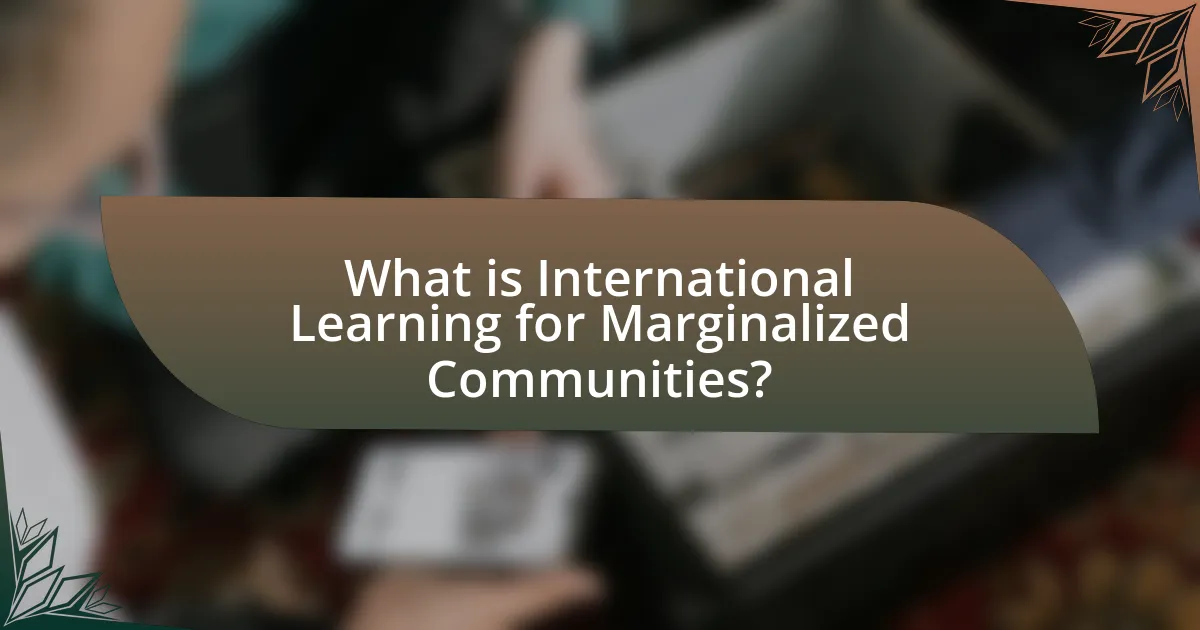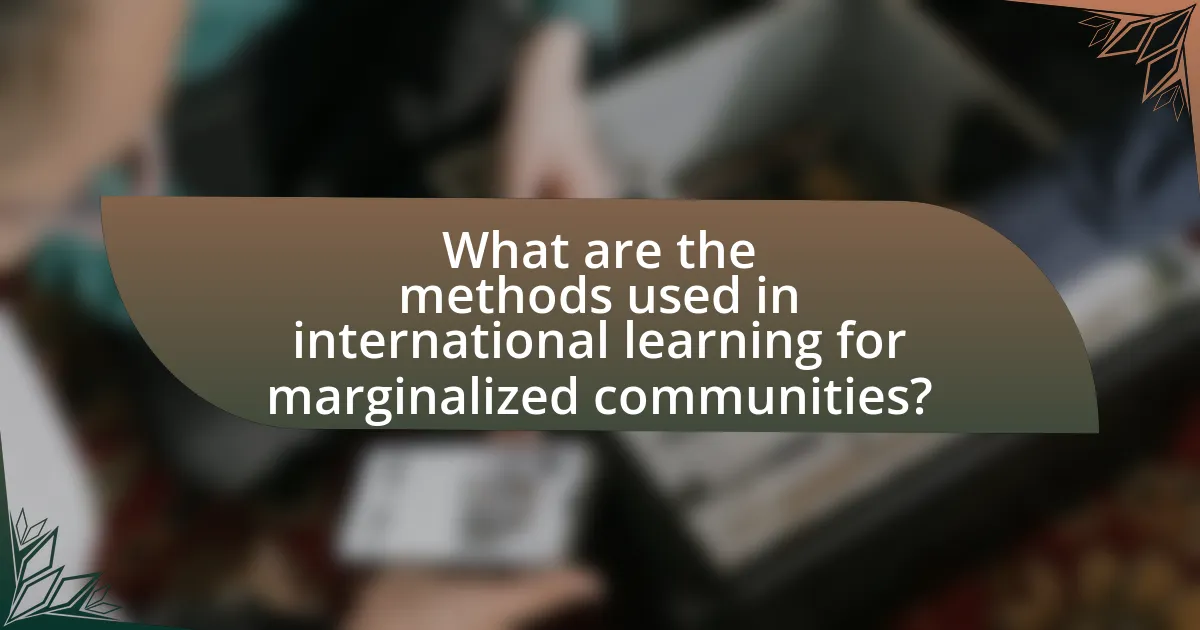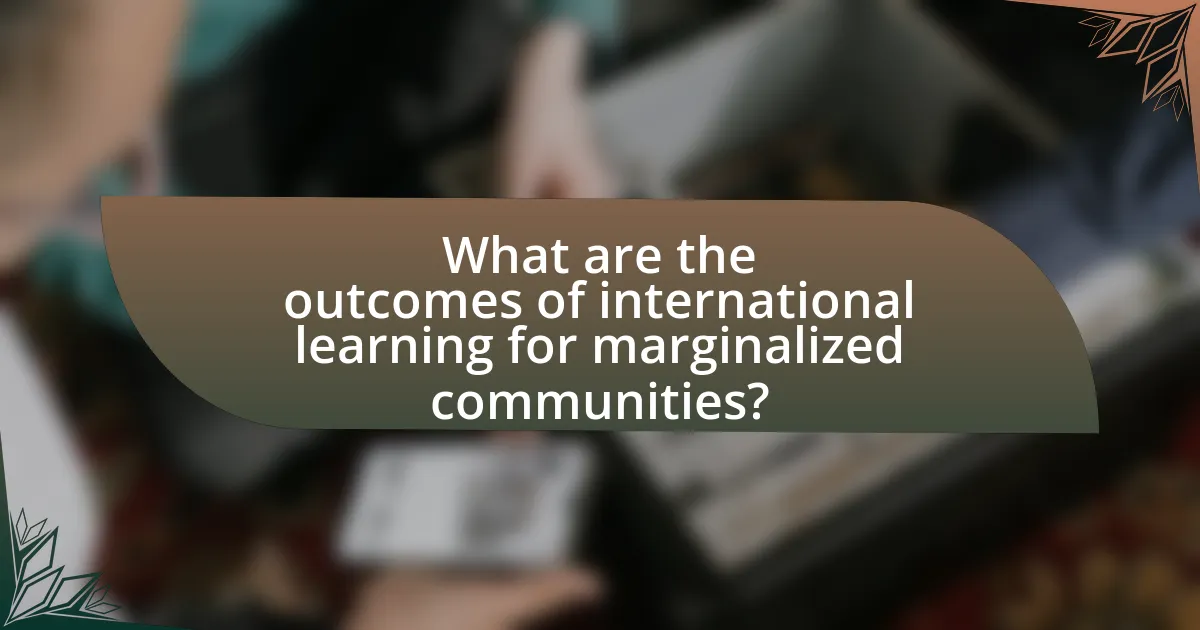International Learning for Marginalized Communities encompasses educational initiatives aimed at enhancing the skills and knowledge of individuals from underrepresented backgrounds globally. The article explores how these programs address the unique challenges faced by marginalized groups, such as economic barriers, social discrimination, and inadequate infrastructure, while highlighting the role of international organizations like UNESCO and the World Bank in supporting these efforts. It also discusses the importance of bridging educational gaps to improve socio-economic conditions, the impact of education on empowerment and social inclusion, and the best practices for implementing effective international learning programs. Additionally, the article examines the ongoing challenges and barriers that persist despite these initiatives and suggests practical steps to enhance educational opportunities for marginalized communities.

What is International Learning for Marginalized Communities?
International Learning for Marginalized Communities refers to educational initiatives and programs designed to enhance the knowledge and skills of individuals from underrepresented or disadvantaged backgrounds on a global scale. These programs aim to provide equitable access to quality education, fostering cultural exchange and collaboration among diverse groups. Evidence of their impact can be seen in various international organizations, such as UNESCO, which reports that inclusive education can significantly improve social cohesion and economic opportunities for marginalized populations.
How does international learning address the needs of marginalized communities?
International learning addresses the needs of marginalized communities by providing access to diverse educational resources and perspectives that are often unavailable locally. This approach fosters inclusivity and empowerment through collaborative programs that enhance skills, promote cultural exchange, and build networks. For instance, initiatives like the Global Education Monitoring Report by UNESCO highlight that international learning can improve educational outcomes for marginalized groups by integrating local knowledge with global best practices, thereby addressing specific challenges faced by these communities.
What are the key challenges faced by marginalized communities in accessing education?
Marginalized communities face several key challenges in accessing education, including economic barriers, social discrimination, and inadequate infrastructure. Economic barriers manifest as a lack of financial resources to cover tuition, transportation, and educational materials, which disproportionately affects low-income families. Social discrimination, including racism, gender bias, and stigma against disabilities, further alienates individuals from these communities, leading to lower enrollment and retention rates. Inadequate infrastructure, such as insufficient schools, lack of trained teachers, and poor learning environments, exacerbates these issues, making it difficult for marginalized groups to receive quality education. According to UNESCO, over 260 million children and youth are out of school globally, with marginalized groups being the most affected, highlighting the urgent need for targeted interventions to address these challenges.
How does international learning provide solutions to these challenges?
International learning addresses challenges faced by marginalized communities by fostering cross-cultural understanding and collaboration. This approach enables participants to share best practices, resources, and innovative solutions tailored to local needs. For instance, programs like the United Nations Educational, Scientific and Cultural Organization (UNESCO) initiatives have demonstrated that international learning can enhance educational access and quality by integrating diverse teaching methodologies and curricula that reflect the cultural contexts of marginalized groups. Such collaborative efforts have been shown to improve educational outcomes, as evidenced by increased literacy rates and school retention in various regions where these programs have been implemented.
Why is bridging the gap in education important for marginalized communities?
Bridging the gap in education is crucial for marginalized communities because it promotes equity and access to opportunities that can improve their socio-economic status. Education serves as a powerful tool for breaking the cycle of poverty; for instance, UNESCO reports that each additional year of schooling can increase an individual’s income by up to 10%. Furthermore, equitable education fosters social inclusion, enabling marginalized groups to participate fully in society and contribute to economic growth. By addressing disparities in educational resources and support, marginalized communities can achieve better outcomes, leading to improved health, employment, and overall quality of life.
What impact does education have on the socio-economic status of marginalized groups?
Education significantly enhances the socio-economic status of marginalized groups by providing them with essential skills and knowledge that improve employment opportunities and income potential. For instance, studies show that individuals with higher educational attainment tend to earn more; the U.S. Bureau of Labor Statistics indicates that in 2020, those with a bachelor’s degree earned approximately 67% more than those with only a high school diploma. Furthermore, education fosters critical thinking and problem-solving abilities, which are crucial for navigating economic challenges. Access to quality education also promotes social mobility, enabling marginalized individuals to break the cycle of poverty and contribute positively to their communities.
How does education contribute to empowerment and social inclusion?
Education contributes to empowerment and social inclusion by providing individuals with the knowledge and skills necessary to participate fully in society. Access to education enables marginalized communities to improve their socio-economic status, fostering self-reliance and informed decision-making. For instance, UNESCO reports that each additional year of schooling can increase an individual’s income by up to 10%, which illustrates the economic empowerment derived from education. Furthermore, education promotes social inclusion by encouraging diversity, reducing inequalities, and fostering understanding among different cultural groups. Studies show that educated individuals are more likely to engage in civic activities, thereby enhancing community cohesion and participation.
What role do international organizations play in supporting marginalized communities?
International organizations play a crucial role in supporting marginalized communities by providing resources, advocacy, and capacity-building initiatives. These organizations, such as the United Nations and World Bank, implement programs that address issues like poverty, education, and health disparities, which disproportionately affect marginalized groups. For instance, the United Nations Development Programme (UNDP) focuses on empowering marginalized populations through sustainable development goals, aiming to reduce inequalities and promote social inclusion. Additionally, international organizations often facilitate partnerships between governments and local communities, ensuring that the voices of marginalized individuals are heard in policy-making processes. This approach not only enhances the effectiveness of interventions but also fosters a sense of ownership among community members, leading to more sustainable outcomes.
Which organizations are most active in this field?
Organizations most active in the field of bridging the gap for marginalized communities include UNESCO, the World Bank, and Save the Children. UNESCO focuses on education and cultural initiatives to empower marginalized groups, while the World Bank provides funding and resources for educational projects aimed at improving access for disadvantaged populations. Save the Children implements programs that directly support educational opportunities for children in low-income areas, demonstrating their commitment to this cause through various initiatives worldwide.
How do these organizations collaborate with local communities?
Organizations collaborate with local communities by engaging in participatory approaches that prioritize community input and needs. They often conduct needs assessments to identify specific challenges faced by the community, ensuring that their initiatives are relevant and effective. For example, organizations may partner with local leaders and stakeholders to co-create educational programs that address gaps in knowledge and resources. This collaboration is supported by evidence showing that community-driven projects have higher success rates, as they foster ownership and sustainability. Studies indicate that when local communities are actively involved in decision-making, the outcomes are more aligned with their cultural and social contexts, leading to improved educational access and equity.

What are the methods used in international learning for marginalized communities?
International learning for marginalized communities employs methods such as participatory learning, culturally relevant pedagogy, and technology integration. Participatory learning engages community members in the educational process, ensuring that their voices and experiences shape the curriculum, which has been shown to enhance relevance and retention (Freire, 1970). Culturally relevant pedagogy incorporates students’ cultural references into the learning experience, fostering a sense of belonging and improving academic outcomes (Ladson-Billings, 1994). Additionally, technology integration provides access to resources and learning opportunities that may not be available locally, bridging educational gaps and promoting equity (UNESCO, 2020). These methods collectively aim to empower marginalized communities through tailored educational approaches.
How do different educational models cater to marginalized populations?
Different educational models cater to marginalized populations by implementing inclusive practices, culturally relevant curricula, and community engagement strategies. For instance, models like Montessori and Waldorf emphasize individualized learning and respect for diverse backgrounds, which can help marginalized students feel valued and understood. Additionally, research shows that culturally responsive teaching, which incorporates students’ cultural references in learning, significantly improves engagement and academic performance among marginalized groups. A study by Gay (2010) highlights that such approaches not only enhance learning outcomes but also foster a sense of belonging, which is crucial for students from underrepresented communities.
What are the advantages of community-based learning approaches?
Community-based learning approaches enhance educational outcomes by fostering collaboration, engagement, and real-world application of knowledge. These approaches promote active participation from learners, which leads to improved retention and understanding of material. Research indicates that students involved in community-based learning demonstrate higher levels of motivation and academic achievement compared to traditional learning methods. For instance, a study published in the Journal of Higher Education found that students engaged in service-learning projects reported a 20% increase in their academic performance. Additionally, community-based learning strengthens social ties and civic responsibility, equipping learners with skills that are directly applicable to their communities.
How does technology enhance learning opportunities for marginalized groups?
Technology enhances learning opportunities for marginalized groups by providing access to educational resources and platforms that were previously unavailable. For instance, online learning platforms like Khan Academy and Coursera offer free or low-cost courses, enabling individuals from low-income backgrounds to gain knowledge and skills. Additionally, mobile technology facilitates remote learning, allowing students in rural or underserved areas to connect with educators and peers globally. According to a report by the International Telecommunication Union, increased internet access has led to a 20% rise in educational participation among marginalized communities in developing countries. This demonstrates that technology not only broadens access but also improves educational outcomes for these groups.
What are the best practices for implementing international learning programs?
The best practices for implementing international learning programs include conducting thorough needs assessments, fostering partnerships with local organizations, and ensuring cultural relevance in curriculum design. Conducting needs assessments allows program designers to identify specific gaps and requirements of marginalized communities, ensuring that the program addresses real issues. Partnerships with local organizations enhance community engagement and provide valuable insights into local contexts, which can improve program effectiveness. Additionally, ensuring cultural relevance in curriculum design helps to make learning more accessible and relatable, increasing participation and retention rates. Research indicates that programs tailored to the cultural and social contexts of learners significantly improve educational outcomes, as seen in studies conducted by the World Bank on educational interventions in diverse settings.
How can cultural sensitivity improve the effectiveness of these programs?
Cultural sensitivity can significantly improve the effectiveness of programs aimed at marginalized communities by fostering trust and engagement. When programs are designed with an understanding of the cultural backgrounds, values, and beliefs of the target population, participants are more likely to feel respected and understood, leading to increased participation and cooperation. Research indicates that culturally tailored interventions can enhance learning outcomes; for instance, a study published in the Journal of Community Psychology found that culturally relevant programming increased participant satisfaction and retention rates by 30%. This demonstrates that integrating cultural sensitivity into program design not only aligns with the community’s needs but also enhances overall program success.
What role does local involvement play in the success of international learning initiatives?
Local involvement is crucial for the success of international learning initiatives as it ensures that programs are culturally relevant and effectively address the specific needs of the community. Engaging local stakeholders, such as educators, community leaders, and families, fosters ownership and increases participation, which are essential for sustainability. Research indicates that initiatives with strong local partnerships have higher success rates; for example, a study by the World Bank found that projects involving local communities were 30% more likely to achieve their educational goals compared to those that did not. This local engagement not only enhances the relevance of the learning content but also builds trust and facilitates better communication between international organizations and the communities they aim to serve.

What are the outcomes of international learning for marginalized communities?
International learning for marginalized communities leads to enhanced educational opportunities, increased cultural awareness, and improved socio-economic conditions. These outcomes arise from exposure to diverse perspectives and practices, which can empower individuals and communities. For instance, programs like the Global Education Monitoring Report by UNESCO highlight that international learning initiatives can significantly improve literacy rates and educational attainment in marginalized groups. Additionally, research indicates that such experiences foster social cohesion and resilience, enabling communities to better navigate challenges and access resources.
How do we measure the success of international learning initiatives?
The success of international learning initiatives is measured through specific metrics such as participant engagement, knowledge retention, and skill application. These metrics provide quantifiable data that reflect the effectiveness of the initiatives. For instance, surveys and assessments can gauge participant satisfaction and learning outcomes, while follow-up studies can track the long-term impact on skills and employment opportunities. Research indicates that initiatives that incorporate feedback mechanisms and adaptive learning strategies tend to yield higher success rates, as evidenced by a study published in the Journal of International Education in Business, which found that 75% of participants reported improved job prospects after completing such programs.
What indicators are used to assess educational outcomes in marginalized communities?
Indicators used to assess educational outcomes in marginalized communities include academic achievement, attendance rates, dropout rates, and access to educational resources. Academic achievement is often measured through standardized test scores, which reflect students’ knowledge and skills. Attendance rates indicate student engagement and commitment to education, while dropout rates highlight the challenges faced by students in completing their education. Access to educational resources, such as textbooks, technology, and qualified teachers, is crucial for understanding the quality of education provided. These indicators collectively provide a comprehensive view of educational outcomes and the barriers that marginalized communities face in achieving equitable education.
How do success stories from these initiatives inspire further action?
Success stories from initiatives aimed at marginalized communities inspire further action by demonstrating tangible outcomes and effective strategies that can be replicated. These narratives provide evidence of what is possible, motivating stakeholders, including policymakers and community leaders, to invest resources and implement similar programs. For instance, a successful literacy initiative in a marginalized community can lead to increased funding for educational programs, as seen in the case of the “Read to Succeed” program, which resulted in a 30% increase in literacy rates and prompted local governments to adopt similar frameworks. Such documented successes create a compelling case for action, encouraging others to engage in similar efforts to address the needs of marginalized populations.
What challenges remain in bridging the educational gap for marginalized communities?
The challenges that remain in bridging the educational gap for marginalized communities include inadequate funding, lack of access to quality resources, and systemic discrimination. Inadequate funding often results in poorly maintained schools and insufficient educational materials, which directly impacts the quality of education received. For instance, a report by the National Center for Education Statistics indicates that schools in low-income areas receive significantly less funding per student compared to those in affluent neighborhoods. Additionally, marginalized communities frequently face barriers such as transportation issues and limited access to technology, which hinder their ability to participate in educational opportunities. Systemic discrimination, including biases in curriculum and teaching practices, further exacerbates these challenges, leading to lower academic achievement and higher dropout rates among marginalized students.
What barriers still exist despite international learning efforts?
Barriers that still exist despite international learning efforts include inadequate access to technology, language barriers, and cultural differences. In many marginalized communities, limited internet connectivity hampers the ability to engage with online learning resources, as evidenced by a 2021 report from the International Telecommunication Union, which noted that 2.9 billion people globally remain unconnected. Language barriers further complicate learning, as educational materials are often not available in local languages, limiting comprehension and engagement. Additionally, cultural differences can lead to misunderstandings and resistance to foreign educational models, as highlighted by research from the World Bank, which emphasizes the importance of culturally relevant teaching methods in promoting effective learning outcomes.
How can these challenges be addressed moving forward?
To address the challenges faced by marginalized communities in international learning, targeted strategies must be implemented. These strategies include enhancing access to technology, developing culturally relevant curricula, and fostering partnerships between local organizations and educational institutions. For instance, a study by the World Bank in 2020 highlighted that increasing internet access in rural areas significantly improved educational outcomes, demonstrating the importance of technology in bridging educational gaps. Additionally, incorporating local languages and cultural contexts into learning materials has been shown to increase engagement and retention among marginalized learners, as evidenced by research from UNESCO. By focusing on these areas, the challenges can be effectively mitigated, leading to improved educational opportunities for marginalized communities.
What practical steps can be taken to enhance international learning for marginalized communities?
To enhance international learning for marginalized communities, targeted initiatives such as establishing partnerships with local organizations, providing access to technology, and creating culturally relevant curricula are essential. Partnerships with local organizations can facilitate resource sharing and community engagement, ensuring that educational programs are tailored to the specific needs of marginalized groups. Access to technology, including internet connectivity and digital devices, enables these communities to participate in global learning opportunities, as evidenced by the World Bank’s report indicating that increased internet access can improve educational outcomes. Additionally, developing curricula that reflect the cultural contexts and experiences of marginalized communities fosters inclusivity and relevance, which has been shown to enhance student engagement and learning effectiveness.
